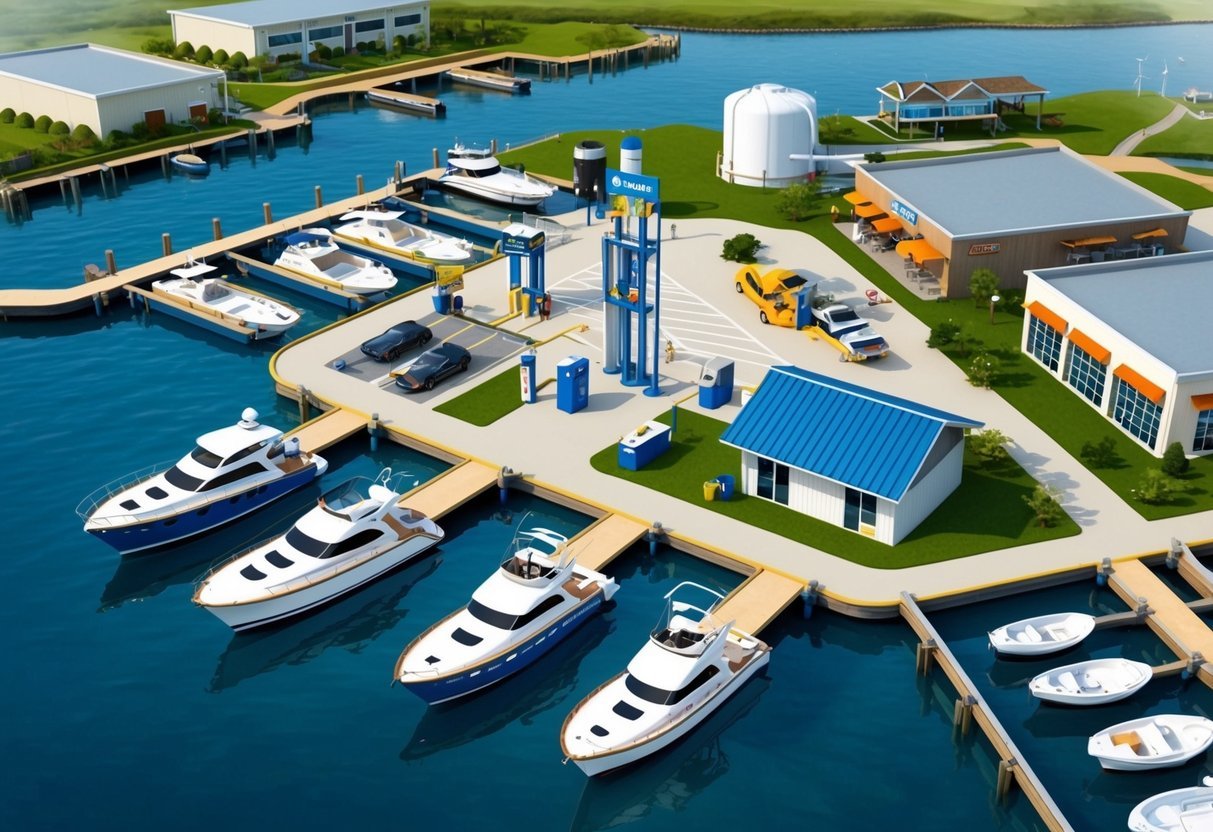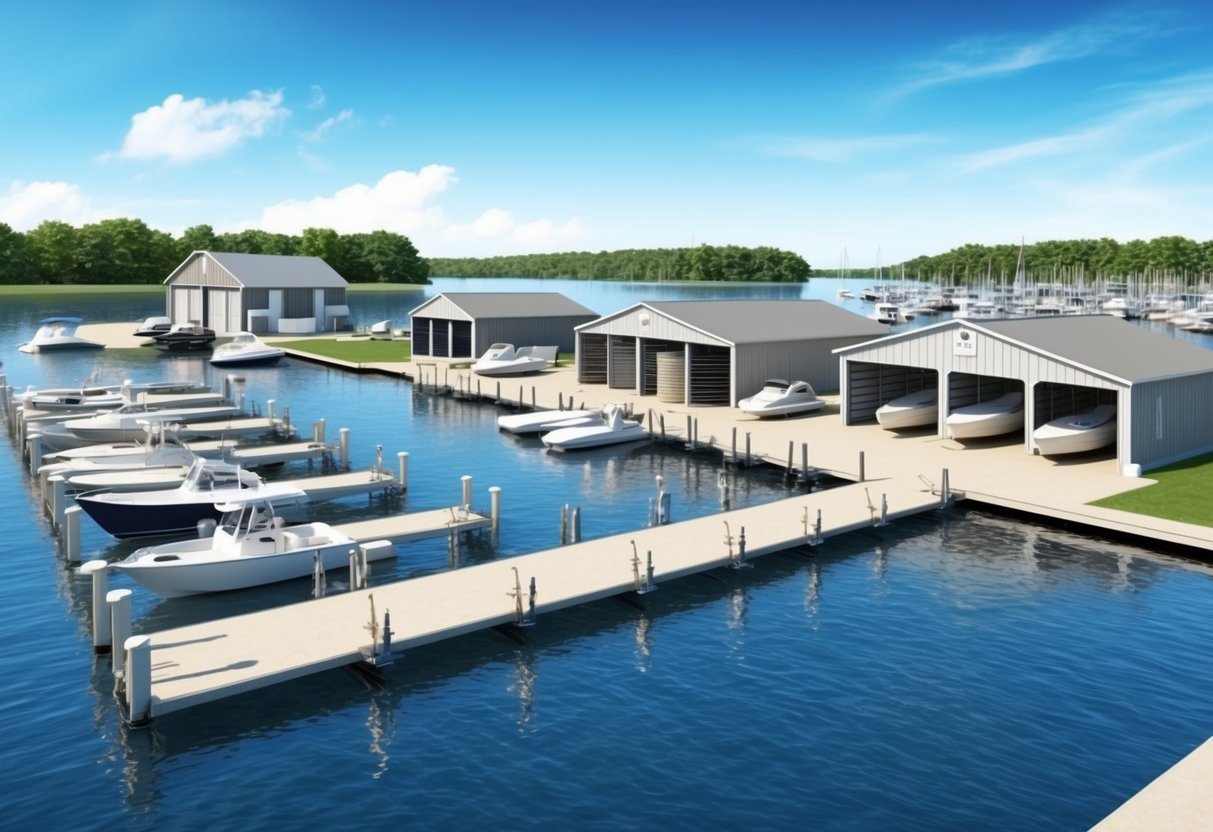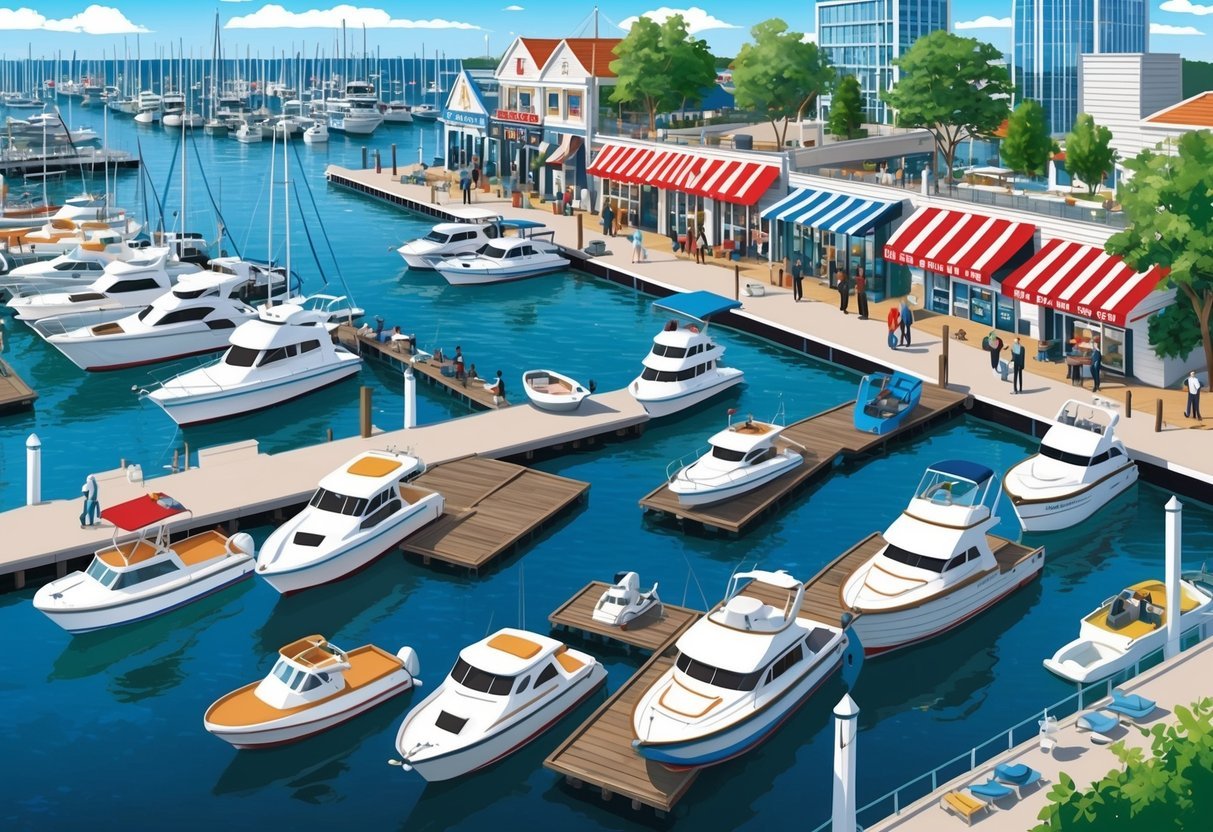Investing in marinas can offer unique opportunities for real estate investors seeking a blend of steady income and asset appreciation.
Marinas operate as both real estate holdings and businesses, presenting a distinct investment profile that requires careful consideration. Understanding the key factors involved in this investment type is crucial for making informed decisions.

We recognize that the marina industry has its peculiarities that set it apart from standard real estate investments.
Evaluating aspects like location, operational costs, and market demand can significantly impact the potential success of such an investment.
Our aim is to shed light on essential considerations that can guide you in navigating the marina investment landscape effectively.
1) Location and Accessibility

When evaluating a marina investment, location is fundamental.
We must focus on marinas situated in popular tourist destinations or thriving coastal towns.
Such locations attract boaters and visitors, driving potential revenue.
Accessibility is equally important.
A marina should offer easy access for both watercraft and road vehicles.
The roads leading to the marina must be well-maintained.
This ensures that visitors can reach the marina without hassle, enhancing their overall experience.
We should also consider proximity to essential amenities.
Partnering with nearby hotels, restaurants, and attractions can enhance the marina’s appeal.
Being close to these facilities not only adds convenience for visitors but also creates potential business collaborations.
Environmental factors are significant.
The marina must be in an area with suitable water depths and favorable tidal conditions.
This ensures that boats can dock safely and efficiently, which is vital for the marina’s operations.
Lastly, we ought to examine local zoning regulations.
Some areas may have restrictions that could affect future development or expansion.
Understanding these regulations early on helps us make informed investment decisions.
2) Docking Facilities and Services

When investing in marinas, evaluating the quality of docking facilities and services is crucial.
High-standard facilities attract more boat owners, enhancing revenue potential.
We should look for marinas with modern infrastructure, providing secure and convenient docking options.
The range and quality of services offered can significantly impact a marina’s appeal.
Services such as fuel stations, maintenance, repairs, and provisioning areas add convenience for boaters.
Offering additional services can differentiate a marina, attracting a diverse set of customers.
Accessibility is another important consideration.
We must assess how easy it is for vessels to enter and exit the marina.
Clear navigation paths, ample space for docking, and well-maintained access routes can greatly improve the user experience.
Safety features cannot be overlooked.
Marinas equipped with proper safety measures, including adequate lighting, security patrols, and reliable surveillance systems, ensure the protection of both boats and people.
Customer service is equally important.
Our commitment to exceptional customer support can build loyalty and repeat business.
A friendly, knowledgeable staff that can assist with docking and any issues can enhance customer satisfaction.
In terms of amenities, offering shower facilities, lounges, and laundry services can enhance the on-site experience for boaters.
These value-added features contribute to making a marina more attractive and comfortable for longer stays.
3) Water Depth and Tides
When considering investing in marinas, one critical factor to assess is the water depth.
We need to ensure the marina can accommodate various types of boats, from small recreational vessels to larger yachts.
Assessing the depth ensures that boats can dock safely and access the marina without complication.
Tidal variations are another important aspect.
These changes can impact navigability and accessibility.
It is crucial that we understand the range of high and low tides in the chosen location to maintain smooth operations.
This knowledge helps prevent potential issues such as boats being unable to access the marina during low tides.
Monitoring both tidal patterns and water depth is also essential for ensuring the safety of the boats.
Ensuring a marina’s design accounts for these factors can prevent damage to boats and infrastructure.
In areas with significant tidal variations, floating docks can be a viable solution to accommodate changes in water levels.
Water depth and tide analysis should be part of the initial feasibility study before making investment decisions.
Collecting reliable data will help avoid costly mistakes and ensure long-term profitability.
In coastal areas, understanding potential environmental impacts due to tides and water depth is also vital.
This foresight ensures compliance with local environmental regulations.
Planning for these natural conditions can shield us from unexpected costs and liabilities.
4) Security Measures
When investing in marinas, security is a critical factor that we must prioritize.
The safety of both property and patrons hinges on effective measures.
A well-thought-out security plan not only protects assets but also enhances the reputation of the marina.
Implementing advanced access control systems can significantly improve security.
By restricting entry points and monitoring them, we can control who has access to the premises.
This reduces unauthorized entry and potential threats.
Investing in quality locks and robust security systems is essential.
These tools protect boats, equipment, and facilities from theft.
We should also ensure that all valuables are securely stored and not easily accessible to potential criminals.
Good lighting is a strong deterrent to crime.
Ensuring that the marina is well-lit at night increases visibility and discourages malicious activities.
Lighting should be strategically placed to cover all areas, including parking lots and dock sections.
Conducting regular security audits helps identify potential vulnerabilities.
By staying proactive, we can adapt our security measures to emerging threats.
Engaging security professionals to assess the premises can offer insights into necessary improvements.
Fostering a community among marina users adds another layer of security.
Encouraging users to get to know each other facilitates vigilance.
A community that looks out for one another can quickly identify and report suspicious activities.
Security is not just about tools and technology; it also involves staying informed about local crime trends.
By keeping up-to-date with law enforcement reports, we can anticipate issues and adjust security protocols accordingly.
Our commitment to security reaffirms the bond of trust with our clients and partners.
5) Storage Options

When investing in marinas, evaluating storage options is crucial.
The two primary types are wet slips and dry storage.
Wet slips provide boats with water access year-round, while dry storage keeps vessels on land, often in a warehouse.
The availability of space is a key factor.
With heavy demand for boat storage, strategically maximizing space can boost profitability.
High demand also means it’s essential to ensure that storage facilities meet customer expectations for security and maintenance.
Consider climate when assessing storage options.
In areas prone to harsh weather, indoor storage or covered options are typically advantageous to protect boats from damage.
This affects potential revenue streams, as providing premium options can attract more clients willing to pay for better protection.
We should also think about the regulations governing storage facilities.
Local zoning laws and environmental regulations can affect the types of storage we can offer.
Understanding these rules is fundamental to ensuring compliance and avoiding legal issues.
Maintenance services tied to storage, like cleaning and winterization, are offerings that can enhance the business model.
By providing these services, we streamline operations and offer convenience to boat owners.
These added services can foster client loyalty and provide additional revenue opportunities.
6) Environmental Impact

When considering marina investments, assessing the environmental impact is crucial.
As responsible investors, we must evaluate how operations affect natural ecosystems.
This not only preserves biodiversity but also ensures compliance with environmental regulations.
Reducing carbon and water footprints in marina operations can align with sustainable practices.
Employing energy-efficient systems and advanced water management techniques helps minimize negative effects on the surrounding environment.
Marinas often face challenges related to pollution, primarily from boat maintenance activities.
Implementing strict waste disposal measures and encouraging environmentally friendly practices among stakeholders can mitigate these issues.
The preservation of water quality is another critical factor.
Poor water conditions can deter potential visitors, impacting profitability.
Therefore, investors should prioritize initiatives that maintain or enhance water quality.
Finally, considering climate change’s long-term effects on marinas is essential.
Sea-level rise and increased storm activity can affect infrastructure.
Planning for climate resilience can protect assets and support sustainable business development.
Market Analysis

When investing in marinas, it’s essential to assess regional demand and the competitive landscape.
Evaluating local market conditions can guide sound investment decisions.
Local Demand
Understanding local demand involves examining the maritime activities and demographics of the area.
We should consider the number of registered boaters, sailing clubs, and the popularity of water sports.
Proximity to tourist destinations and high-income residential areas often indicates strong potential demand.
The economic stability of the region also plays a crucial role.
We should analyze historical data on marina occupancy rates and waiting lists. Seasonality can affect demand, with tourism-heavy areas seeing fluctuations in usage.
Identifying trends helps us understand whether the market can support new investments or if it is saturated.
Competition and Saturation
Competition and saturation are key factors affecting the profitability of a marina.
We must analyze the number and quality of existing marinas in the vicinity.
High saturation can lead to reduced pricing power and profitability.
Reviewing competitors’ services, pricing, and facilities can offer insights into market gaps.
It’s important to examine whether our planned offerings stand out.
We should also assess future developments in the area that could increase saturation levels further.
New entrants, expansions, and the potential for mergers and acquisitions are important considerations.
By evaluating these factors, we can better position ourselves for a successful marina investment.
Financial Considerations

When investing in marinas, understanding the financial landscape is crucial.
This involves evaluating initial investment costs and identifying diverse revenue streams to maximize returns.
Initial Investment Costs
Acquiring a marina requires substantial initial capital.
Costs may include purchasing the property, which varies significantly based on location and size.
Marinas in prime locations or with modern amenities often command higher prices.
We must also consider costs like inspections, permitting, and legal fees.
Renovations, such as upgrading docks or facilities, can further add to our expenses.
We should assess the condition of the marina and budget for necessary improvements.
Identifying potential hidden costs early ensures we’re financially prepared for the investment’s full scope.
Revenue Streams
Successful marinas offer multiple revenue opportunities.
Beyond basic docking fees, which are usually the primary income source, marinas can generate additional income through various services.
These might include renting out storage spaces, boat maintenance services, and retail operations like selling boating supplies.
Offering membership programs and organizing events can also boost revenue.
Furthermore, amenities such as restaurants or cafes on-site add value and attract more visitors.
Our strategy should focus on diversifying these revenue streams to ensure consistent cash flow and mitigate risks associated with market fluctuations.
Location and Accessibility

When considering an investment in marinas, location is crucial.
We should prioritize marinas situated in popular boating destinations.
Proximity to tourist attractions, such as coastal towns and beaches, can significantly boost the marina’s appeal.
Accessibility is another vital factor.
It’s beneficial for a marina to be close to major transportation routes.
This ensures that both local and visiting boaters can reach it easily.
Well-connected properties tend to attract more visitors.
With location, climate is also important.
In regions with mild weather, marinas may operate year-round.
This can offer a more consistent income stream compared to those in colder areas with limited seasonal activities.
Local regulations and governance should not be overlooked.
Some areas have strict zoning laws and environmental regulations.
Understanding these restrictions can save us from unexpected complications.
| Key Considerations | Details |
|---|---|
| Popularity of Location | Situated near tourist attractions |
| Accessibility | Close to major roads and airports |
| Climate | Mild weather for year-round operation |
| Local Regulations | Zoning laws and environmental rules |
Finally, we should assess nearby amenities, such as restaurants and shopping opportunities.
These can greatly enhance the marina’s attractiveness.
A well-located marina can become a hub for social and recreational activities, benefiting both the boating community and our investment.
Frequently Asked Questions

In this section, we aim to address common queries that arise when discussing investments in marina properties.
We’ll touch on financial metrics, operational management, environmental factors, legal challenges, industry trends, and the incorporation of technology.
What are key financial metrics to evaluate before investing in a marina?
Evaluating the potential return on investment is crucial.
We should consider cap rates, which typically range from 8% to 14%, and focus on revenue streams such as boat storage fees.
Analyzing cash flow stability and operational revenue will provide us with a comprehensive financial picture.
How does the operational management of a marina impact its profitability?
Effective operational management is vital.
We must ensure that facilities, such as docking and storage options, are well-maintained.
The efficiency of services offered and management’s ability to adapt to seasonal changes can significantly influence a marina’s success.
What are the environmental considerations to take into account when investing in marina properties?
We must evaluate the potential environmental impact of marina activities.
This includes assessing water quality, managing waste, and ensuring compliance with local environmental regulations to maintain sustainable operations.
What legal or regulatory challenges could investors face with marina investments?
Investors may encounter zoning laws, permits, and environmental regulations.
Understanding these legal aspects will help us navigate potential roadblocks and mitigate risks associated with marina ownership.
How do trends in the boating industry influence the success of marina investments?
Market trends in boating play a substantial role in marina profitability.
We should closely monitor consumer preferences, changes in recreational boating habits, and economic conditions that affect demand for marina services.
What role does technology play in the management and operation of modern marinas?
Technology is integral in modern marina operations.
We can utilize it for reservation systems, security measures, and facility management.
Adopting innovative solutions can enhance customer experience and increase operational efficiency.

